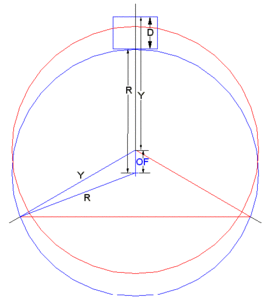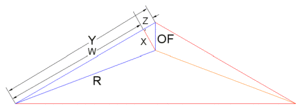Turning an Eccentric Hole in a 3-Jaw Chuck
by Ron Thibault
You can turn an offset (eccentric) hole in a workpiece using only a 3-jaw chuck. You insert a block between the workpiece and one jaw, then clamp.
Figure 1 shows the concept. The red circle represents the workpiece clamped normally with its center on the chuck centerline (the three 120 deg apart lines). The blue circle represents the workpiece with block D clamped in one jaw (with the total assembly center on the chuck centerline). This gives an offset for the workpiece itself of OF.
To calculate the size of the Block D needed to get Offset OF the triangles shown in Figure 1 are further broken down as shown in Figure 2. The angle between lines Z and OF is 60 degrees. The following values are defined:
- In Figure 1:
- D = Length of the Block
- OF = Offset of Workpiece
- R = Radius of Workpiece
- Y = Effective Radius of Block/Workpiece assembly
- In Figure 2:
- Z = OF * cos(60)
- X = OF * sin(60)
- R2 = X2 + W2
- Thus:
- W2 = Square Root(R2 - X2)
- Y = W + Z
- D = Y - R + OF
- D = W + Z - R + OF
- D = Square Root(R2 - X2) + Z - R -OF
- D = Square Root(R2 - (OF * sin(60))2) + (OF *cos(60)) - R + OF
- D = Square Root(R2 - (OF * sin(60))2) + 1.5OF - R
As an example (using the eccentrics for Minnie):
- For:
- R = 1.6875 inches
- OF = 0.313 inches
- D = 0.448 inches

